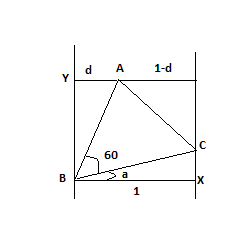17 - General Trigonometry Questions Answers
if secA-tanA=3
then find the value of (5cosA+4cotB)??
jus a hint
First replace cotB by cotA.
because it is wrongly printed by you.
answer by NIKHIL is correct
Which of the following angles are co-terminal angles: 480 , -240 or 600
how can we get it which is co-terminal and what does co-terminal means?????
Coterminal angles are angles in standard position (angles with the initial side on the positive x-axis) that have a common terminal side. For example 30°, –330° and 390° are all coterminal.
To find a positive and a negative angle coterminal with a given angle, you can add and subtract 360° if the angle is measured in degrees or 2π if the angle is measured in radians.
480 and -240 are co terminal angles because 480-360 = 120 and -240+360 = 120

is there any need to know or learn the proof pf formulas of trigo
No, For making a good command in trigonometry, only implementation is a need. But for your knowledge you can proof these results
if x,y,z are acute and cos x= tan y , cos y = tanz , cos z = tan x, then the value of sin x is ;
by 1st equation sec y = √(1+cos2x) so cos y = 1/ √(1+ cos2x)
by 3rd equation sec z = cot x so tan z = √(cot2x - 1)
on putting these 2 values in 2nd equation we get
1/ √(1+ cos2x) = √(cot2x - 1)
so sin2x = (1+cos2x)(cos2x-sin2x)
or sin2x = (2-sin2x)(1-2sin2x)
or sin2x = 2-4sin2x-sin2x+2sin4x
or 2sin4x-6sin2x+2 = 0
now solve it for sinx
The distance between two parallel lines is 1.A point 'A' is chosen to lie between the lines at a distance 'd' from the first line. Triangle ABC is an eqilateral triangle with 'B" on one line and 'C' on the other line.Then AB is equal to(in terms of d).
In triangle BCX
BC = seca
so AB = seca
now in triangle ABY
cos(60+a) = d/seca
so 1/2 cosa - √3/2 sina = d cosa
or tana = (1-2d)/√3
now calculate seca

Find the number of solutions of the equation 2cos²(x/2)sin²(x) = x² + 1/x² , 0 < x ≤ π/2 .
max of sin and cos are 1 so max of left is 2
but x² + 1/x² ≥ 2x(1/x) = 2
so only solution will be obtained for 2cos²(x/2)sin²(x) = 2
so (1+cosx)(1-cos²x) = 2 which is impossible,so i think no solution
Find the value of 16cos(2π/15)cos(4π/15)cos(8π/15)cos(14π/5).
I think the last term would be cos(14π/15)
We know that cos(14π/15) = -cos(π/15)
so 16cos(2π/15)cos(4π/15)cos(8π/15)cos(14π/15)
= -16cos(π/15)cos(2π/15)cos(4π/15)cos(8π/15)
= -[8/sin(π/15)]2sin(π/15)cos(π/15)cos(2π/15)cos(4π/15)cos(8π/15)
= -[8/sin(π/15)]sin(2π/15)cos(2π/15)cos(4π/15)cos(8π/15)
take the similar steps
